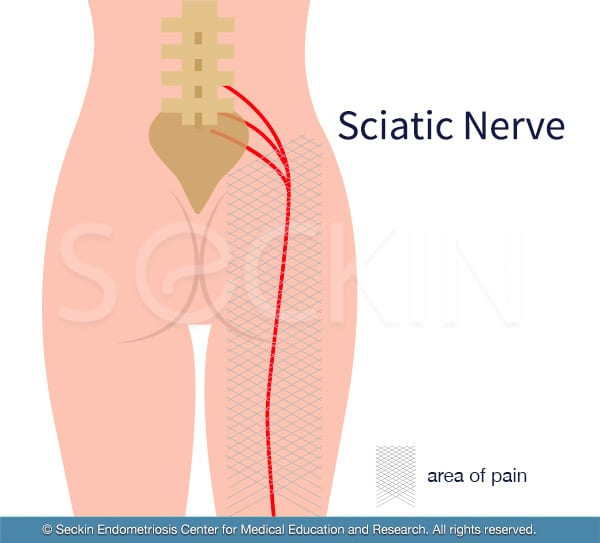Sciatic endometriosis is a condition where tissue resembling the lining of the uterus grows around the sciatic nerve. This puts pressure on the nerve and causes pelvic, hip, and leg pain.
Causes of sciatic endometriosis
While the exact cause of endometriosis is not clear, the cause of sciatic endometriosis is. When the endometrium starts to grow outside the uterus and around the nerves, it can cause damage to those nerves. This is known as neuropathy. When the affected nerve is the sciatic nerve, the condition is called sciatic endometriosis. Inflammation can cause pain that can begin as periodical. However, as the disease progresses, it becomes chronic and eventually leads to scarring and constant pain.
Symptoms of sciatic endometriosis
The sciatic nerve is the body’s largest nerve, connecting the spinal cord with the legs and feet. It runs from each side of the lower spine into the back of the thigh and down to the foot.

Sciatic endometriosis puts pressure on the sciatic nerve. Therefore, it can cause pain, numbness, cramping, and a tingling sensation in the lower back, hips, buttocks, thighs, calves, knees, and feet. Patients usually feel pain in the back of their leg and, which radiates towards the heel.
Other symptoms of sciatic endometriosis are similar to those of regular endometriosis and may include:
- pelvic pain
- irregular periods
- severe period pain (dysmenorrhea)
- pain during intercourse (dyspareunia)
- fatigue
- bloating and nausea
- depression and anxiety
The pain may start just before the beginning of your period and last for several days after. However, the interval between episodes of pain may shorten with time, and the cyclical pain may gradually become constant. Sciatic endometriosis may also cause “foot drop” or the inability to lift the front of your foot, and negatively affect walking ability. It may also cause loss of sensation, muscle weakness, and reflex alteration.
Get a Second Opinion
Our endometriosis specialists are dedicated to providing patients with expert care. Whether you have been diagnosed or are looking to find a doctor, they are ready to help.Our office is located on 872 Fifth Avenue New York, NY 10065.
You may call us at (212) 988-1444 or have your case reviewed by clicking here.
Diagnosis of sciatic endometriosis
Sciatic endometriosis can be very difficult to diagnose as it usually presents like sciatica. However, the condition almost always occurs together with regular endometriosis. If a woman already has a diagnosis of endometriosis and shows symptoms of sciatica, sciatic endometriosis may be suspected. Different imaging techniques may be used to diagnose it. These include magnetic electromyography, computed tomography (CT) scan, magnetic resonance imaging (MRI), or surgery
A test called the Lasègue’s test, or straight leg raise test can also indicate sciatic endometriosis. During the test, the patient lies down on her back. The doctor then raises the patient’s legs with the knees held in a straight position. If the sciatic nerve is under pressure, the patient experiences sciatic pain when the legs reach an angle between 30 and 70 degrees in relation to the exam table.
Early diagnosis is key as sciatic endometriosis can result in irreversible nerve damage caused by recurrent cycles of bleeding and scarring if left untreated.
Treatment
As in the case of regular endometriosis, oral contraceptives may also help reduce the pain caused by sciatic endometriosis.
Over-the-counter painkillers and anti-inflammatory medications such as ibuprofen may help reduce the pain caused by sciatic endometriosis. Topical painkiller creams can also reduce the pain.
Gentle exercise under the supervision of a skilled physiotherapist who specializes in endometriosis can also help. This can include walking, yoga, swimming, and physiotherapy
Laparoscopic surgery to remove the endometrial tissue that has grown around the sciatic nerve can be effective in treating severe cases of sciatic endometriosis. Sometimes endometriosis can reach the so-called sciatic foramen. This is the opening in the pelvic bone where the nerves and blood vessels from the pelvis pass through and travel down to the lower legs. It is important that an experienced endometriosis excision surgeon performs the surgery.
Our approach
We make sure that we evaluate patients with sciatic endometriosis with magnetic resonance imaging (MRI) and surgery. Surgery has to be performed by a very experienced endometriosis excision surgeon who knows how to identify the main blood vessel in the pelvic area with its subdivisions. He or she will then need to extend to the area before the sacral bone, or triangular bone at the base of the spine, and reach the nerves found in this region.
Patient story
“I wish my doctors pointed me in Seckin’s direction a lot sooner. I would’ve had more years to spend with my kids.” –Christine Eboli
Get a Second Opinion
Our endometriosis specialists are dedicated to providing patients with expert care. Whether you have been diagnosed or are looking to find a doctor, they are ready to help.Our office is located on 872 Fifth Avenue New York, NY 10065.
You may call us at (646) 960-3080 or have your case reviewed by clicking here.
Dr. Seckin is an endometriosis specialist and women’s reproductive health advocate. He has been in private practice for over 30 years at Lenox Hill Hospital with a team of highly skilled personnel.
Dr. Seckin specializes in advanced laparoscopic procedures and is recognized for his expertise in complex cases of deep infiltrating endometriosis of the pelvis. He is particularly dedicated to performing fertility-preserving surgeries on cases involving the ovaries.
He has developed patented surgical techniques, most notably the “Aqua Blue Excision” technique for a better visualization of endometriosis lesions. His surgical techniques are based on precision and microsurgery, emphasizing organ and fertility preservation, and adhesion and pain prevention.
Dr. Seckin is considered a pioneer and advocate in the field of endometriosis.
